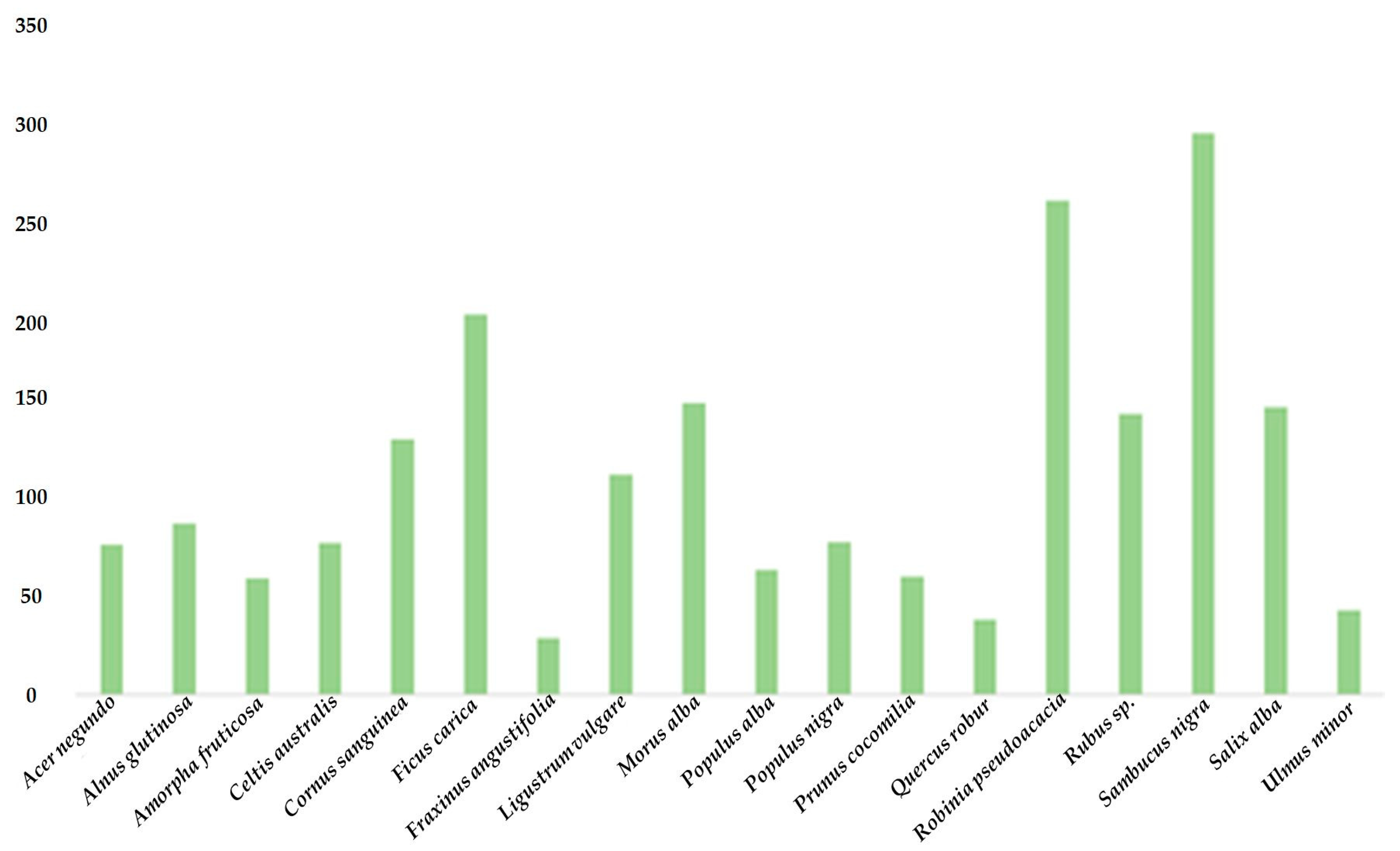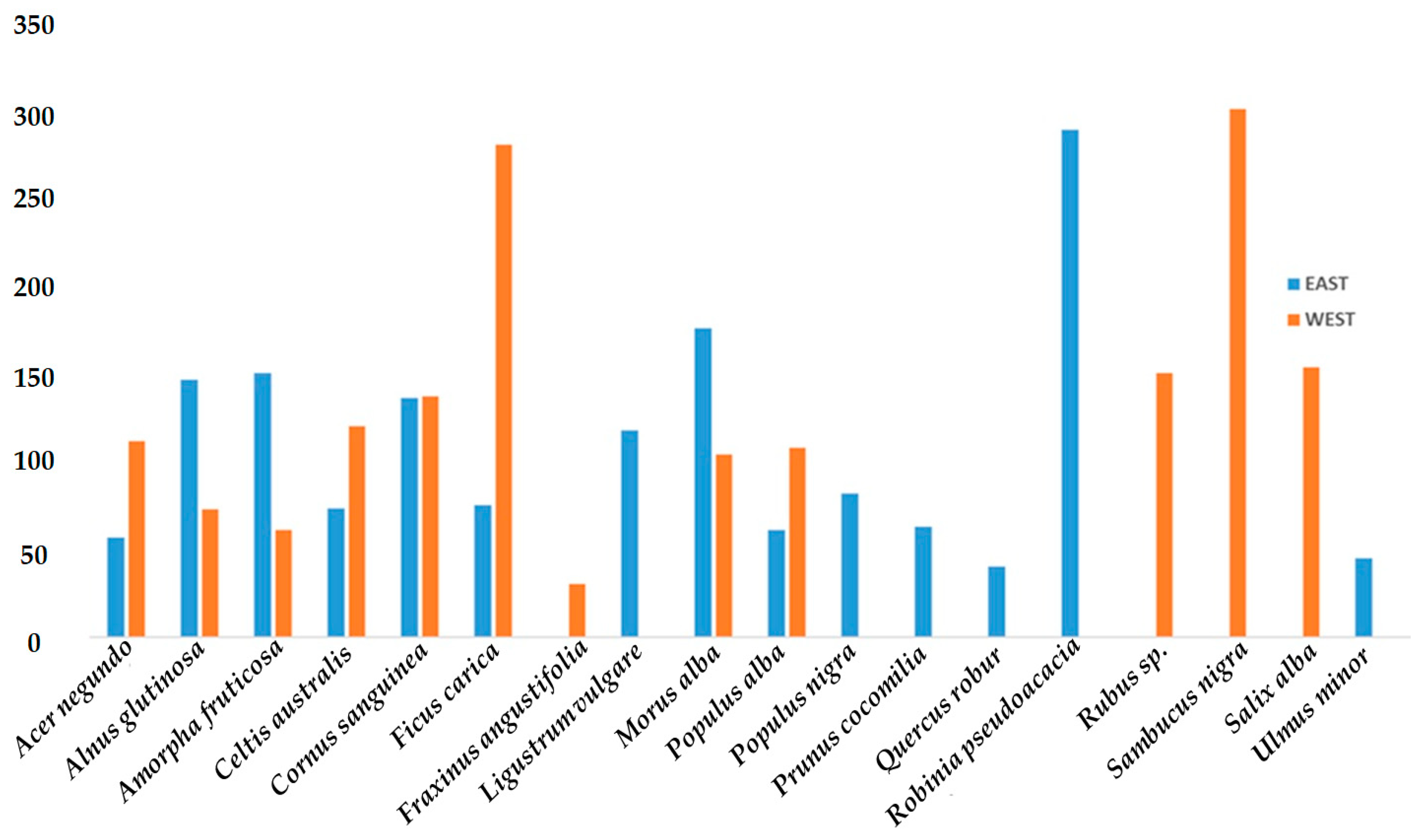1. Introduction
The Mediterranean Basin ranks as one of the world’s most biodiverse regions and is the third most significant hotspot for plant diversity. It supports 25,000 plant species, with over half endemic [
1]. However, this region is also one of the planet’s most threatened, classified as the fourth most significantly altered biodiversity hotspot [
2] and the second in habitat area loss. Additionally, it has been identified as a climate change hotspot [
3]. The Mediterranean climate is characterized by pronounced seasonality in temperature and precipitation. Overall, species in Mediterranean ecosystems experience significant water stress due to hot, dry summers and cool, wet winters [
4].
The priority habitat 91E0*, consisting of alluvial forests with Alnus glutinosa and Fraxinus excelsior, is a critical ecosystem along Europe’s riverbanks and floodplains. These forests are essential for maintaining biodiversity, regulating water cycles, and providing ecosystem services such as flood control and wildlife habitats. In Greece, the alluvial forests of the Nestos Delta are particularly notable for their unique composition and ecological importance, including 22 habitat types (Annex I Dir. 92/43/EEC) [
4]. Given the escalating impacts of climate change, particularly in regions like the Mediterranean Basin, the conservation and management of alluvial forests become increasingly vital. These ecosystems play a crucial role in retaining soil moisture and preventing soil collapse, particularly in areas adjacent to water bodies. The preservation of these areas is not only essential for maintaining biodiversity but also for safeguarding the hydrological stability of the landscape, which is increasingly threatened by changing climate patterns. Therefore, this study aims to evaluate the regeneration status and diversity of woody species in the priority habitat 91E0* in the Nestos Delta to quantify the conservation status of the alluvial forest.
2. Materials and Methods
2.1. Study Area
The study area is in SCI GR1150010 (Natura 2000 site) in the northeastern region of Greece and includes alluvial forests of the priority habitat 91E0 in the Nestos Delta. The alluvial forests are found in the floodplain areas and are influenced by the river’s hydrological dynamics, which create a unique environment for biodiversity. The region’s climate is humid, according to the UNEP Climate Zone Classification System [
5]. Fifteen (15) circular permanent plots, with a radius of 15 m each, were established in May 2019. They were randomly and homogeneously distributed along the habitat (
Figure 1).
2.2. Woody Plant Species
Data collection was a comprehensive process that took place in May and July 2023 across 14 of the 15 plots; 1 plot (plot #6) was inaccessible due to flooding. Within each of the accessible 14 plots, the composition and diversity of woody tree species (species richness) were recorded. The Index of Regeneration (IR) was calculated by multiplying the regeneration density (per m2) by the average regeneration height (cm), providing a metric of regeneration extent. This approach enables conclusions to be drawn regarding the condition of the forests and ongoing dynamic processes, validating their recovery and particularly assessing the long-term persistence of wood regeneration following targeted ecosystem restoration and conservation efforts.
3. Results
3.1. Woody Plant Species Composition and Diversity
In the studied area, 13 plant species belonging to 12 genera from 10 families were recorded (
Table 1). The most numerous families were Salicaceae (23.07%) and Moraceae (15.38%). In addition, 76.92% of plant species are native/non-range restricted, whereas 23.07% are alien/established providing valuable insights into the dynamics of plant distribution. According to the life form spectrum of the vegetation, Phanerophytes (92.30%) contributed the most to the total number of recorded species in the study area, followed by European–SW Asian (7.69%). The documented species chorological spectrum revealed that European–SW Asian species comprised 30.76% of the total flora, followed by East Mediterranean species (15.28%), Euro–Siberian (15.38%), and North American (15.38%).
3.2. Regeneration of Alluvial Wood
Our results indicate that the regeneration of
Populus alba is the most extended (31.1%) in the alluvial forest (
Table 2).
Cornus sanguinea L.,
Morus alba L., and
Alnus glutinosa (L.) Gaertn. regeneration are also extended, whereas regeneration of
Fraxinus angustifolia is very limited (0.21 cm/m
2).
The average regeneration height was used to indicate the regeneration quality, attributing a greater height to a greater degree of affirmation. The comparison of the regeneration height among tree species measured in 14 permanent plots indicated that the tallest seedlings are the ones of
Sambucus nigra (300 cm) and
Robinia pseudoacacia, followed by
Ficus carica (264 cm and 203 cm, respectively) (
Figure 2).
By comparing the average regeneration height among various species on the two different banks (East and West) of the Nestos River, it appears that the average regeneration height is significantly higher on the west bank (
p < 0.0001,
t-Test) (
Figure 3).
4. Concluding Remarks
Two years after the removal of alien species, the regeneration index (IR) for both A. fruticosa and A. negundo showed a substantial decline from 31.75 and 21.12 cm m−2 to 2.07 and 2.6 cm m−2, respectively. Concurrently, space was created to expand native tree species such as C. sanguinea, M. alba, and P. alba. The results indicate that the regeneration of P. alba is currently the most extended (31.1%) in the alluvial forest, with C. sanguinea, M. alba, and A. glutinosa regeneration also showing significant extension. In contrast, the regeneration of F. angustifolia remains very limited (0.21 cm m−2), signaling the need for targeted restoration actions.
Furthermore, the restoration initiatives have positively impacted the composition and regeneration dynamics of the alluvial forest in the Nestos Delta. Nevertheless, it is recommended that ongoing monitoring activities be systematically conducted to track the potential expansion of alien species and implement appropriate management and conservation measures. Additionally, restoration activities should be considered for Fraxinus angustifolia, which is not prominently present in the forest stands and exhibits limited regeneration on the west bank of the Nestos River.
Moreover, our project in the Nestos Delta effectively integrates multiple reforestation objectives by enhancing biodiversity through the restoration of native and keystone species, supporting economic utilization via sustainable harvesting and the development of non-timber forest products, and increasing carbon sequestration by prioritizing species with high carbon storage potential. Additionally, this project contributes to ecological stability by preventing soil erosion and maintaining hydrological balance, while fostering community involvement and collaboration with stakeholders to ensure long-term conservation and alignment with broader environmental and economic goals. This holistic approach ensures that the project benefits both the ecosystem and local communities.
Finally, proposed improvements and extensions to the restoration technique are described as follows: (a) Enhanced Monitoring and Adaptive Management: Systematic, continuous monitoring and adaptive management strategies are essential to track the re-expansion of alien species and respond to changes in forest dynamics, considering Greece’s evolving environmental conditions; (b) Restoration of Vulnerable Species: Targeted efforts should focus on increasing the regeneration of F. angustifolia and other underrepresented native species through planting, soil improvement, and protection measures; (c) Integration of Climate-Resilient Species: Incorporating climate-resilient species into restoration projects will help ensure the long-term stability and resilience of the forest ecosystem in the face of climate change; (d) Community Engagement: Involving local communities and stakeholders in restoration efforts can enhance conservation outcomes and support the expansion of restored areas; and (e) Research and Innovation: Ongoing research and innovation in restoration techniques, including the use of native species with high ecological value and new technologies like drones, can further improve restoration success.
Author Contributions
Conceptualization, A.D.S. and E.K.; methodology, A.D.S. and E.K.; software, A.D.S., E.K., E.A. and P.K.; validation, A.D.S.; formal analysis, A.D.S. and E.K.; investigation, A.D.S., E.K., E.A., P.K., G.M. and G.K.; resources, A.D.S., E.K., E.A., P.K., G.M. and G.K.; data curation, A.D.S.; writing—original draft preparation, A.D.S.; writing—review and editing, A.D.S.; supervision, A.D.S.; project administration, E.K.; funding acquisition, E.K. All authors have read and agreed to the published version of the manuscript.
Funding
This work is funded by the LIFE PRIMED (LIFE17 NAT/GR/000511) project, which is co-financed by the Greek Green Fund (GRFU).
Institutional Review Board Statement
Not applicable.
Informed Consent Statement
Not applicable.
Data Availability Statement
The data presented in this study are available on request from the corresponding author due to ongoing analyses and planned future publications.
Acknowledgments
We thank our collaborator N.E. Chatzipavlis for his support throughout data collection in the field.
Conflicts of Interest
The authors declare no conflicts of interest.
Abbreviations
The following abbreviations are used in this manuscript:
| UNEP | United Nations Environment Programme |
| IR | Index of Regeneration |
References
- Myers, N.; Mittermeier, R.A.; Mittermeier, C.G.; da Fonseca, G.A.B.; Kent, J. Biodiversity hotspots for conservation priorities. Nature 2000, 403, 853–858. [Google Scholar] [CrossRef] [PubMed]
- Mittermeier, R.A.; Robles-Gil, P.; Hoffmann, M.; Pilgrim, J.D.; Brooks, T.B.; Mittermeier, C.G.; Lamoreux, J.L.; da Fonseca, G.A.B. Hotspots Revisited: Earths Biologically Richest and Most Endangered Terrestrial Ecoregions; CEMEX: Mexico City, Mexico, 2004; p. 390. [Google Scholar]
- Diffenbaugh, N.S.; Giorgi, F. Climate change hotspots in the CMIP5 global climate model ensemble. Clim. Chang. 2012, 114, 813–822. [Google Scholar] [CrossRef] [PubMed]
- Solomou, A.D.; Georgiadis, C.; Cambria, V.E.; Karetsos, G.; Korakaki, E.; Koulelis, P.; Avramidou, E.; Tsagari, K.; Michopoulos, P.; Scarnati, L.; et al. Restoration, management and valorisation of priority habitats of Mediterranean coastal areas. In Proceedings of the X International Agriculture Symposium, Agrosym 2019, Jahorina, Bosnia and Herzegovina, 3–6 October 2019. [Google Scholar]
- Mavrommatis, G.Ν. The Bioclimate of Greece. Relation Between Climate and Natural Vegetation; Forest Research 1; Forest Research Institute: Athens, Greece, 1980; p. 63. [Google Scholar]
| Disclaimer/Publisher’s Note: The statements, opinions and data contained in all publications are solely those of the individual author(s) and contributor(s) and not of MDPI and/or the editor(s). MDPI and/or the editor(s) disclaim responsibility for any injury to people or property resulting from any ideas, methods, instructions or products referred to in the content. |
© 2025 by the authors. Licensee MDPI, Basel, Switzerland. This article is an open access article distributed under the terms and conditions of the Creative Commons Attribution (CC BY) license (https://creativecommons.org/licenses/by/4.0/).














